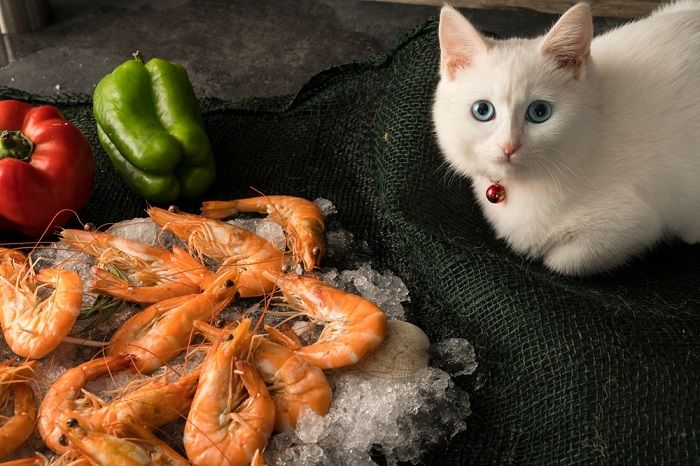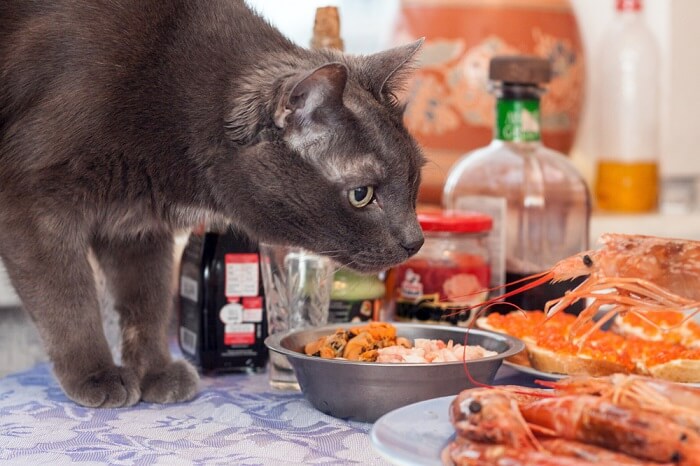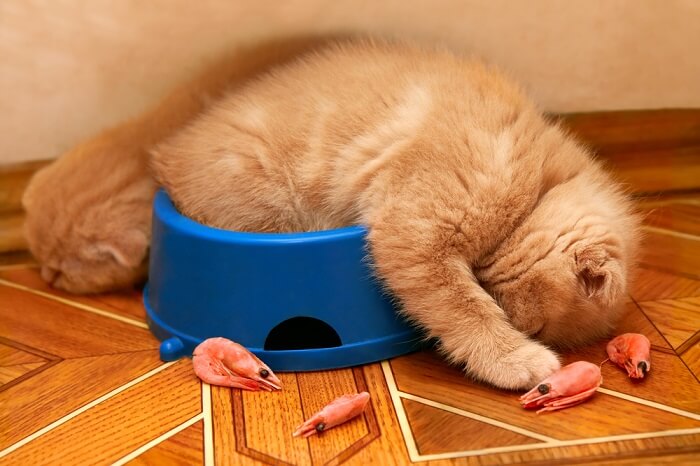
It’s no secret that most cats love the taste of fish, and you’ve probably offered your cat things like tuna or sardines from time to time. But what about shrimps?
Cats can eat cooked shrimp as a treat, but it should not be a regular part of their diet as it does not provide all the necessary nutrients for a complete diet.Quick Overview: Can Cats Eat Shrimp?





Summary of Content
Many Cats enjoy the taste of shrimp, making it a favorite treat for them.. However, there are a few things to be aware of before feeding shrimp to your cat. So, let’s take a look at the nutritional benefits of shrimp for cats, the risks, and how much they can eat!
Is Shrimp Good for Cats?
So, shrimp have a huge array of health benefits to humans, but what about cats?
Shrimp are a tasty, low-fat, low-calorie and protein-rich food source for cats. The vitamins, minerals and antioxidants in shrimp also offer all the same benefits to cats as they do to humans.
Shrimp are a good source of B12, omega-3 and omega-6 fatty acids, and choline, which all can help maintain healthy skin, support a healthy heart and brain function, and reduce inflammation.
Cats can eat all parts of the shrimp, including the head and tail, but the shell should be avoided as it is a choking hazard.
Can Cats Eat Cooked Shrimp?
Yes, cats can eat cooked shrimp as a treat, but it should not be a regular part of their diet as it does not provide all the necessary nutrients for feline health. It is important to remove the shell and tail, and ensure that the shrimp is fully cooked and cooled before offering it to your cat to avoid any potential digestive issues.
Can Cats Eat Shrimp Tails?
While not toxic, shrimp tails can pose a choking hazard, and it is recommended to remove them before offering shrimp to your cat. Ensuring the tails are excluded addresses potential risks and allows your cat to enjoy the protein benefits of shrimp safely.
Can Cats Eat Shrimp Shells?
Similar to shrimp tails, cats can consume shrimp shells, and some cats even appreciate the crunchy texture. Keep in mind that shrimp shells can pose a choking hazard, so generally speaking it’s recommended to remove them. So While it’s relatively safe to let your cat enjoy shrimp shells, it’s crucial to monitor them and ensure they don’t experience any digestive issues.
Can Cats Eat Raw Shrimp?
Although cats can eat raw shrimp, it is safer to feed it thoroughly cooked. Raw shrimp can contain harmful bacteria, pesticides and chemicals that could make your cat unwell, but bacteria are destroyed during the cooking process. Don’t use any oils or seasoning when preparing shrimp for your cat. It is safest to remove the shell as this can be a choking hazard.
How Much Shrimp Can a Cat Eat?

A small amount of shrimp is a tasty and nutritious treat for your cat.
Cats need to eat a complete and balanced commercial cat food containing all their essential nutrition to stay healthy. But adding fresh seafood will add variety and stimulate their senses. As this is a treat in addition to their usual food, half a shrimp for a small cat or one whole shrimp for a large cat would be plenty.
Although shrimp has many great nutritional benefits for cats, it can also be calorific and contribute to weight gain if given too frequently. Treats should only make up 10 percent of your cat’s daily food intake.
How Often Can a Cat Eat Shrimp?
We all like to treat our cats and add variety to keep them interested in their food, and shrimp can be a great way to do this. Treats should make up no more than 10 percent of your cat’s daily food intake, and seafood like shrimp should only be offered occasionally, so half to one full shrimp once or twice a week would be suitable for most cats.
Are Shrimps Used in Commercial Cat Food?
Commercial cat foods are carefully formulated to contain everything your cat needs to stay healthy. These foods come in a myriad of flavors, so there is something to suit every taste! Fish is commonly used as the main source of protein because of its great taste and smell, enticing cats to eat.
Shrimp is used in commercial cat food as a source of protein. It is often found in tasty combinations with other seafood, such as salmon and tuna.
Is Shrimp Bad for Cats?

Don’t serve your cat the shells of shrimp as these can be choking hazards.
Although shrimp are a safe and tasty form of seafood for cats, there are a few risks that you need to be aware of.
Raw shrimp might contain contaminants, such as pesticides, chemicals and antibiotics that are put into the water where shrimp are farmed. These can still be present in the shrimp when it reaches supermarket shelves. Raw shrimp can also carry bacteria, such as E. coli or Salmonella.
You should cook shrimp before feeding it to your cat to destroy these nasty chemicals and bacteria. Remove the shell as it can be a choking hazard.
Shrimp served in oils, seasoning or brine can be harmful to cats. Brine has a high salt content—too much salt can cause extreme thirst, dehydration, lethargy and weakness, and can be fatal if not treated. Other seasoning and oils can be toxic or cause an upset tummy, so fried or battered shrimp are a big no for cats.
The other key thing to remember is that shrimp should only feature in your cat’s diet occasionally—too much causes weight gain and puts your cat at risk of developing diabetes.
Final Thoughts
Cats can eat shrimps in small portions. They should be thoroughly cooked with no seasoning or oils, and the shells removed. Remember that too many shrimps can contribute to weight gain, so half to one shrimp per serving is plenty. Shrimps offer several nutritional benefits to cats and make a great tasty treat!
Frequently Asked Questions
Can cats eat frozen shrimp?
Avoid feeding your cat frozen shrimp that has been processed or packaged as these shrimps will contain high levels of salt and preservatives that could be dangerous for your cat. Fresh, unprocessed frozen shrimps are OK if they are thoroughly defrosted and cooked before serving.
What happens when you give a cat shrimp?
When you give a cat shrimp, most will instinctively love it and want more! If you give a cat plain, cooked shrimp, they should not have any issues. However, if you give a cat raw shrimp, or shrimp that has been prepared with oils, brine or seasoning, it could cause an upset tummy.
Are cats allowed to eat seafood?
Yes, cats love seafood! You can give cats seafood as long as it is fresh and does not contain preservatives or additives and has not been cooked in oil or seasoning. Cats should only be fed fish in moderation, as a treat to supplement their usual complete cat food.








Is this ok?
Yes, it should be perfectly fine. Thanks for asking.
My cat loves those little frozen salad shrimp. I rinse them in water before I give them to her a handful for a treat..
Nice!
Thank you for your quick response. I’m glad I’ve become a member of allaboutcats….Misty’s glad, too!
Thanks for being here, Linda! 🙂
All the best to you and Misty.
I give my 4 yr. old cat who weighs 8.9 ozs. 1 lg. shrimp on Tues. & 1 lg. one on Fri. (2 per wk.). Is this too many shrimp per wk. She is in good health, thank God! Please respond to [email protected]. I look forward to your response!
A couple of shrimp per week is just fine, Linda. Thanks for reaching out!